David C. Bartlett

David Charles Bartlett
"Goes to the Big Roundhouse in the Sky"
April 6, 1929 to March 10, 2015
Submitted by Robert "Sam" Bartlett - Updated March 3, 2019
In lieu of services, a celebration of Dave Bartlett's life took place on Saturday May 30, 2015 at 5pm at the Trolley Museum.
Donations may be made to the Shelburne Falls Trolley Museum, PO Box 272, Shelburne Falls, MA 01370.
The Shelburne Falls Trolley Museum lost its biggest fan when David C. Bartlett passed away quickly at home on Tuesday March 10, 2015. Many people knew him as the museum's ticket seller, always quick with a joke or a tall tale. "Let me see if I can sober up the motorman and we'll get you a trolley ride." he would say to folks after they had bought their passes. But he was also our corporate Clerk, our General Passenger Agent, our Membership Clerk, our Transfer Editor and our Chief Engineer. And to some people, Dave was SFTM.

Dave regales visitors on the old porch at Trolleyfest 2010
In 1991 Dave was invited by founder Tony Jewell to help found SFTM as an entity to perform the restoration of Trolley No. 10, whose story you can find elsewhere on this site. Dave was on the board of directors, and very active in the day-to-day operations both behind the scenes and interacting with our guests, right up until his last day. He brought a strong sense of fiscal responsibility to the board's deliberations, an attention to detail to his various clerk positions, and a sense of humor to the museum's newsletter, The Transfer, of which he was the editor.
His biggest effort in recent years was to get a new 'fire-proof' Car Barn built at SFTM. Here are some pictures of the progress we have made on this project to date.
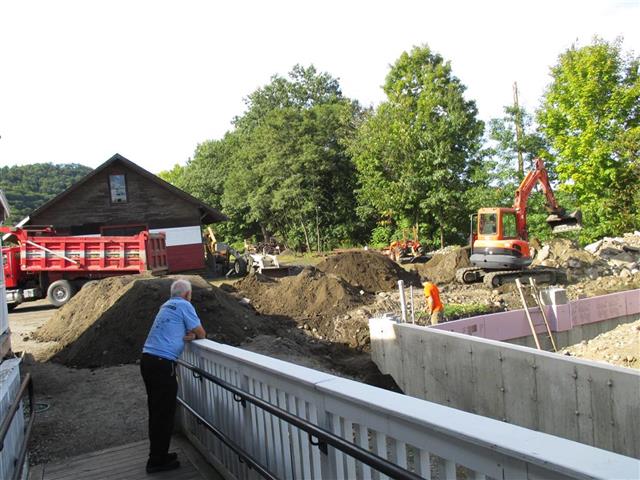
Dave watches the Car Barn foundation being backfilled by Dick and Rob Hillman. Dick was one of Dave's many students at GCC.
Dave worked on the concept, preliminary design and siting and site surveying. He was a major financial backer of the project, and provided technical and moral support to the volunteer crews as well.
Dave also wanted to see the outward appearance of the museum improved, and worked to find funding to have the old H.P. Hood Creamery foundation removed.
(Many of these pictures are meant to be paired side-by-side and share a caption, best viewed on as wide a screen as possible.)
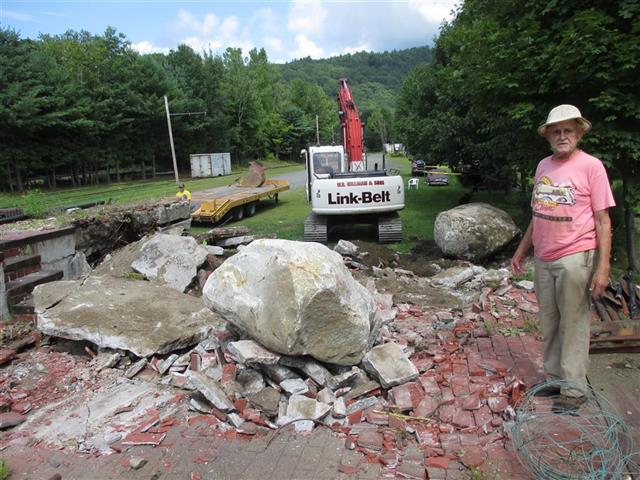

Dave supervises the demolition and removal of the Creamery foundation.
Dave was, of course, much more than a many-hatted museum volunteer. He was well known for his sense of humor. Here is the back story of this beloved husband, father, friend, uncle, grampa, great-grampa, railfan and professor. He would be somewhat embarrassed at this attention, so feel free to stop reading (or skip to some recollections from Dave) when your eyes glaze over.
Dave was born in Worcester, MA, raised in Leicester, MA, the son of Charlotte (Kesseli) and Herbert Lawrence Bartlett, who owned and operated a printing shop in Worcester.
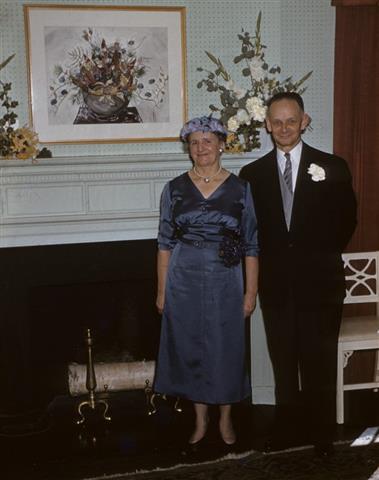
"Bert" and Charlotte Bartlett, Dave's parents March 1957
Dave graduated from Worcester Academy and Worcester Junior College and received his BA and MS in Civil Engineering from UMass Amherst. He served in the Army from 1953 to 1955 in the Signal Corps as a radio repairman.

Dave at Camp Wood, NJ May 1954
Dave worked as a transformer technician for General Electric in Pittsfield, MA, and spent a summer surveying curves and bridges for the Baltimore and Ohio Railroad. He married Mary Morgan Goodwin ("Polly") on March 16, 1957. See below for Polly's recollection of those days.

Mr. and Mrs. David C. Bartlett
His first job after college was in Houlton, ME as a Bridges and Buildings Engineer for the Bangor and Aroostook Railroad from 1957 to 1960.
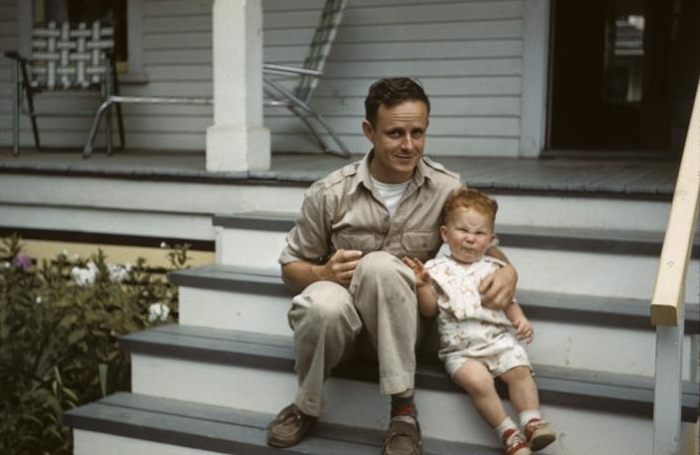
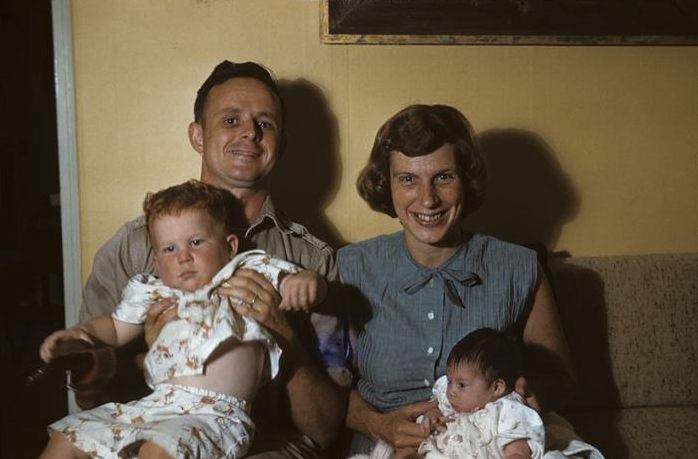
Dave and Sam on the porch, Sam, Dave, Polly, Sally in Houlton, ME 1959
Then they moved to Paxton, MA and he taught at Worcester Junior College 1960-1967. In December 1967 he and Polly moved their family to "Pine Brook Farm" on the outskirts of the village of Shelburne Falls in Buckland, MA. He started the Greenfield Community College Engineering Department and taught Civil Engineering and Computer Science from 1967-1985.
In 1972 Dave donated his structural engineering expertise to the replacement of the Greenfield Pumping Station covered bridge.
Among his joys were his family, spending time in his woods and garden, camping and backpacking in the White Mountains, skiing, travelling by train on this continent and in Europe, and watching trains. Here are some pictures from those times.
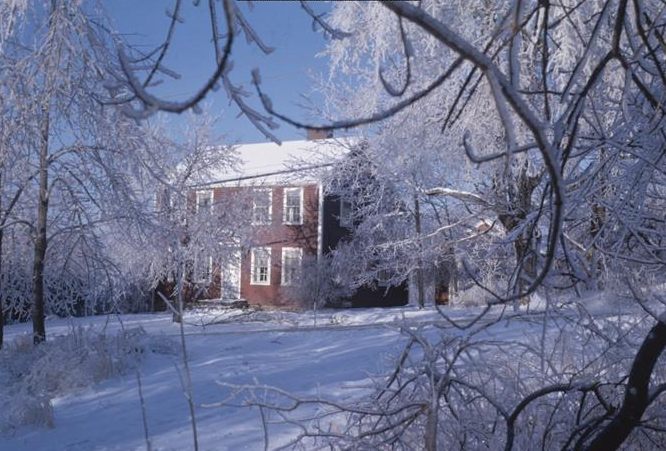
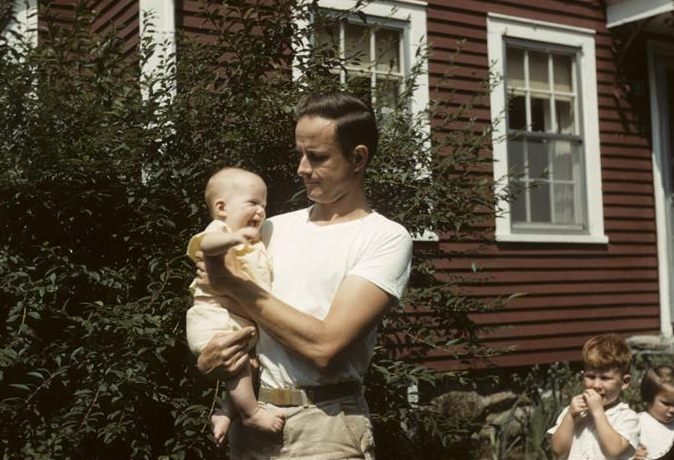
The house on Asnebumskit Road, Paxton, MA - Nancy, Dave, Sam, Sally 1961

Sal, Nancy, Sam, Polly, Dave 1976

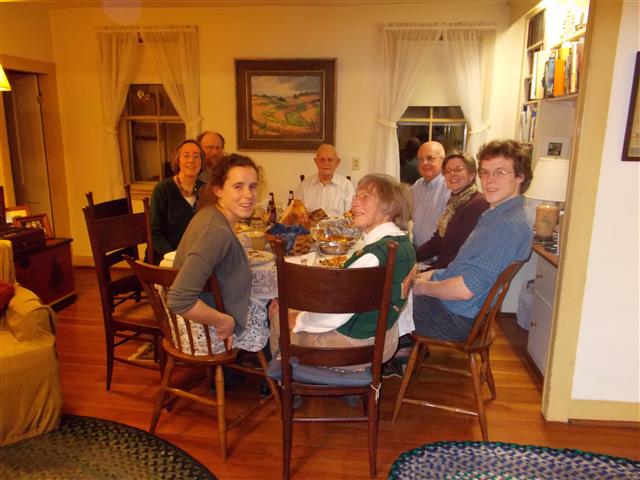
clockwise around the table Dave, Nan, Polly, Sam, Bob, Sal 1979 - Dave, Bob, Sal, Nate, Polly, Jeannie, Marie, Sam 2014
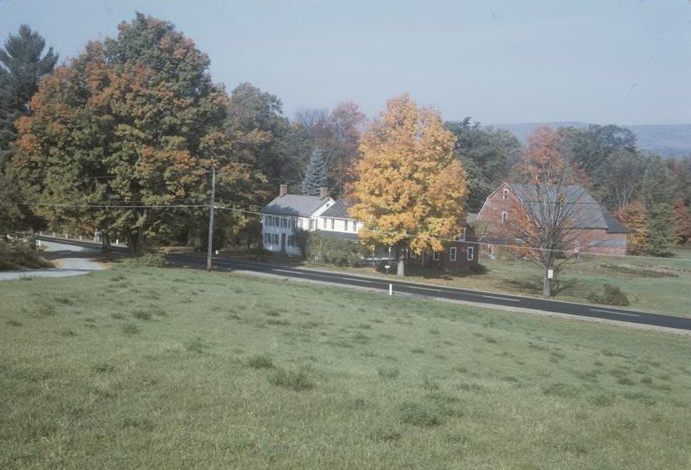
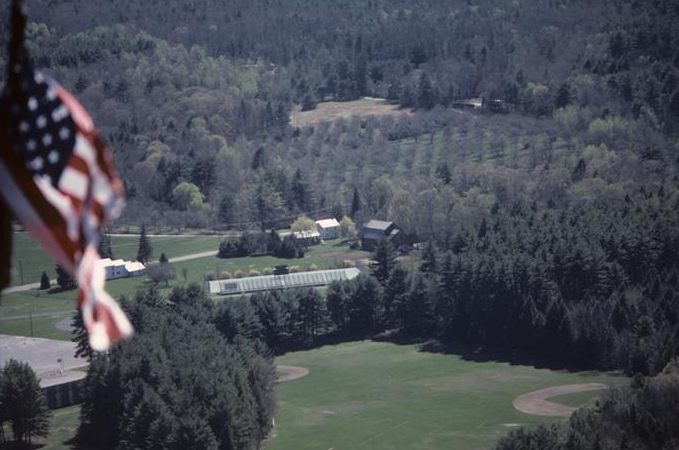
"Pine Brook Farm" Shelburne Falls, MA from Rand Road and from "the Elephant's Back"
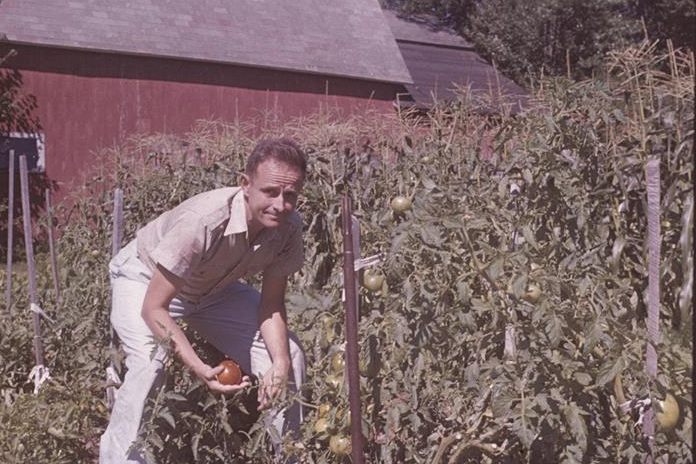
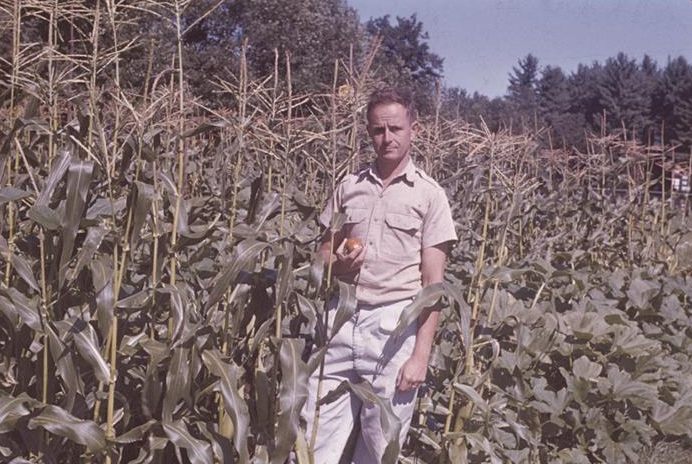
A man out standing in his field...
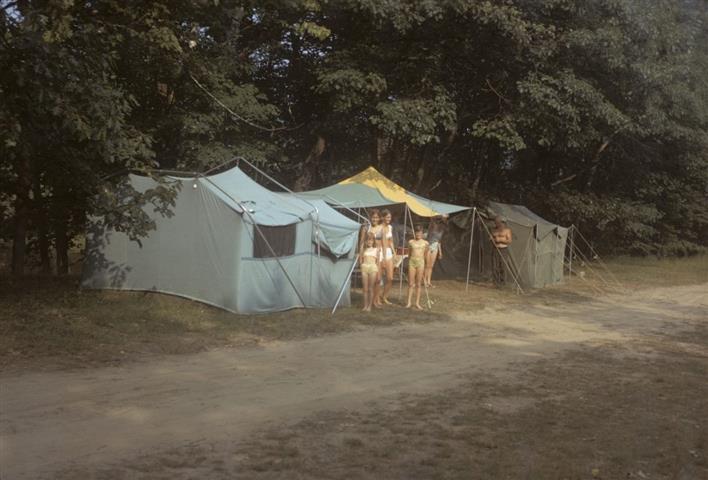
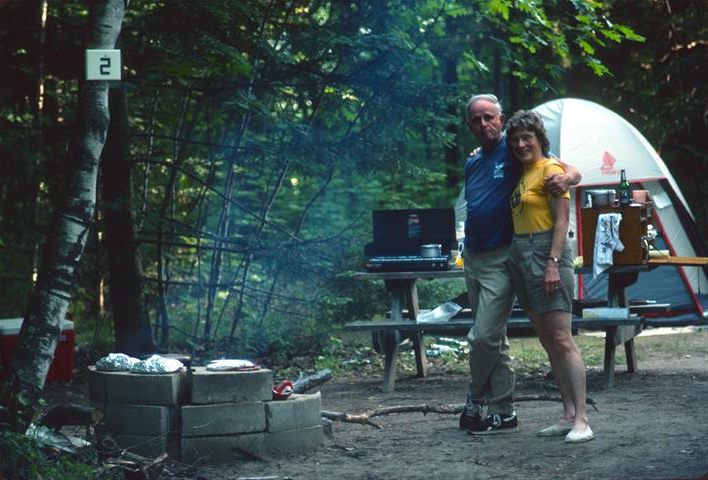
One of many Moose Campground set ups, 1971 - Polly and Dave at Moose Campground, 1993
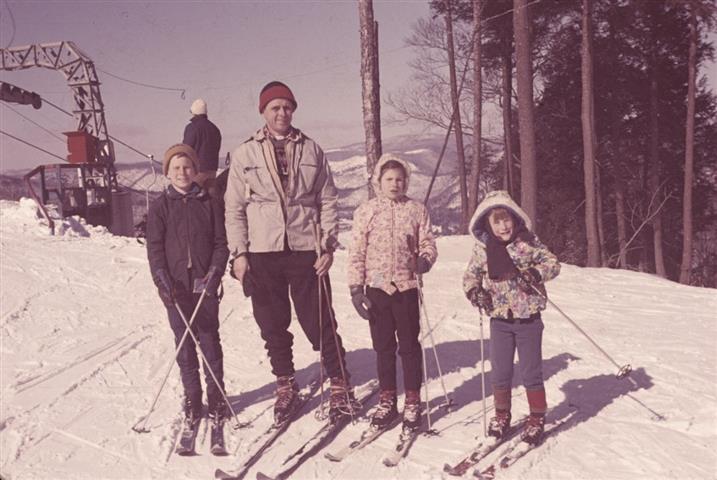
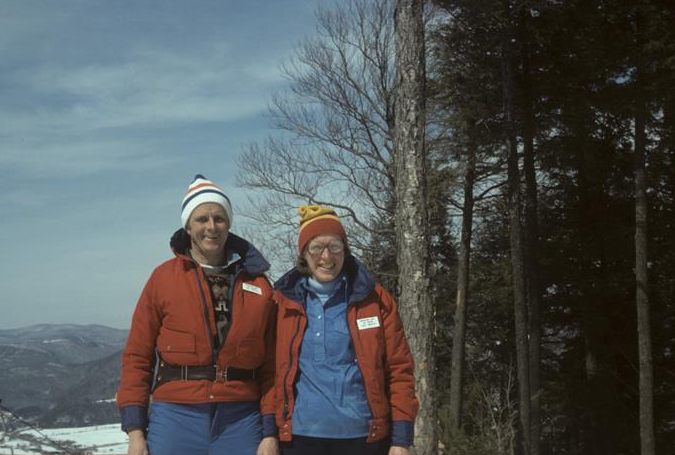
Sam, Dave, Sal, Nan at Thunder Mountain (now Berkshire East) 1969 - Dave and Polly 1978 (At one point all five Bartletts were on Ski Patrol)
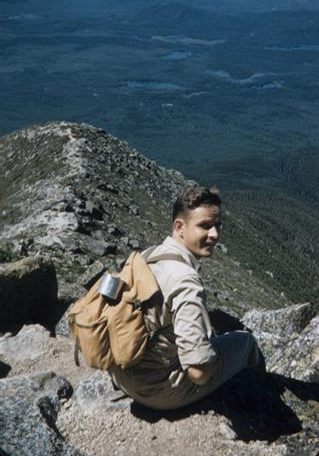
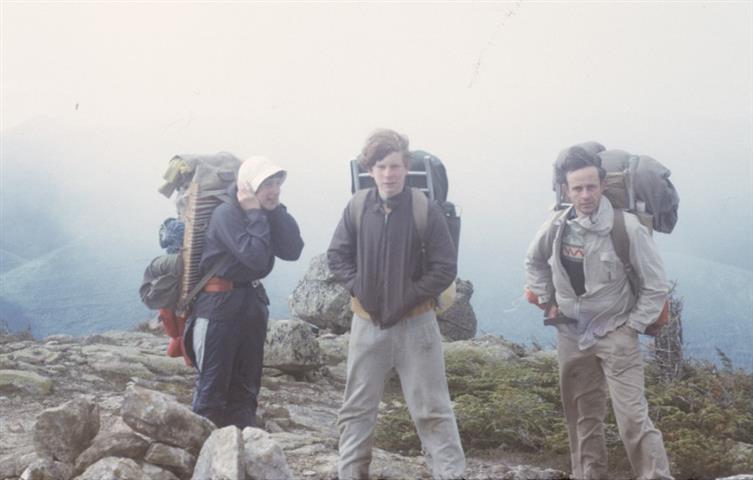
Dave on Katahdin, ME 1957 - Polly, Sam, Dave 1973, probably on the Bond Cliffs, NH
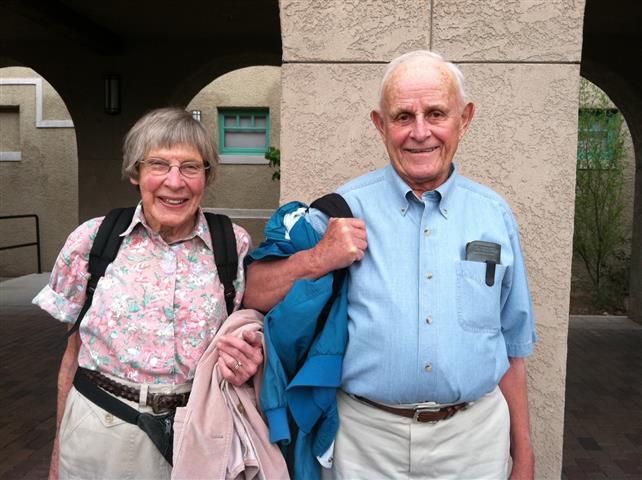
Dave and Polly at the Albuquerque NM Amtrak station
He was an avid railroad photographer as long as steam locomotives roamed the rails and has thousands of color slides of the last days of steam locomotives nationwide. Here are two examples (you can buy these and 40 other Central Vermont Railway David Bartlett slides on a CD at the SFTM Trolleystop Giftshop.)
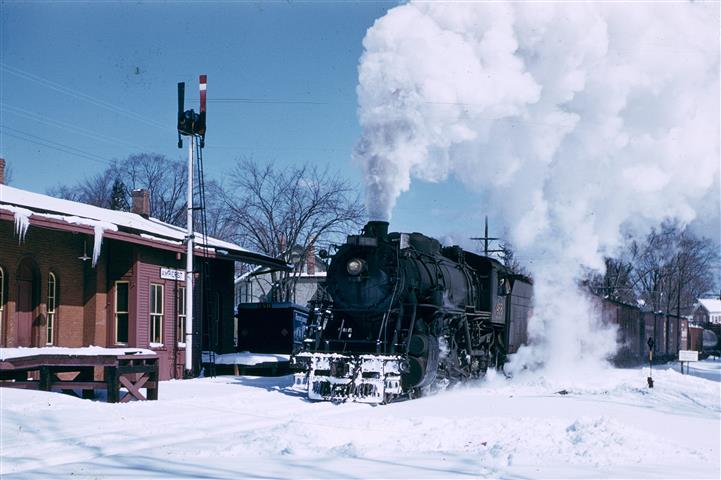
CV 468 southbound at Amherst MA, March 1956, photo by David Bartlett
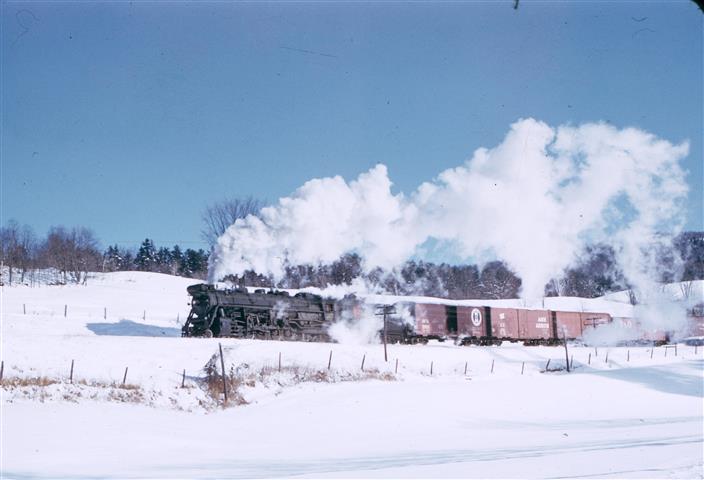
CV 707 at Hartford VT, December 1956, photo by David Bartlett
Family members include his wife of 58 years Mary "Polly" Bartlett, son Robert "Sam" Bartlett and his wife Marie Bartlett of Leyden, daughter Sally Spencer and her husband Robert Spencer of Buckland, and daughter Nancy Bartlett of Albuquerque, NM. He leaves three grandchildren; Jeffrey Bartlett Spencer of Buckland and his fiancee Brenda Culver, Nathan Bartlett of Chicago, and Jeanne Bartlett of Middlebury, VT. He leaves one great-grandson, Nicholas Spencer and was predeceased by a granddaughter, Amy Spencer in 2001.
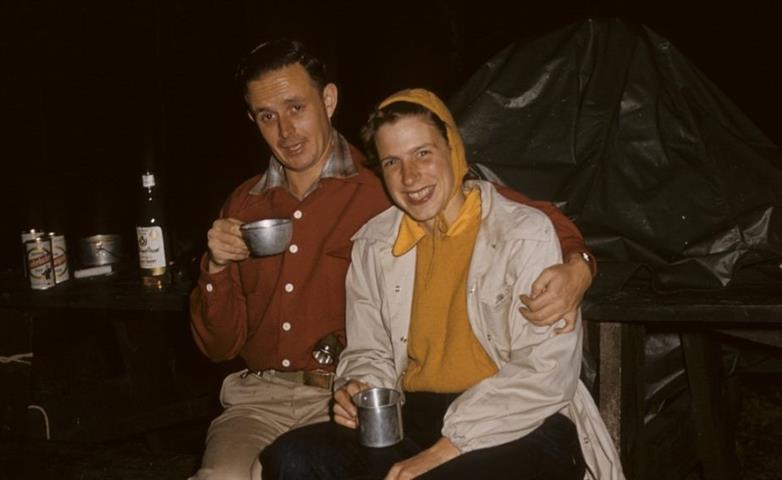
This slide Dave titled "Two Alkies Greylock 11/56
Dave enjoyed his beer, cocktails and wine. Next time you lift a glass, lift one for the Old Man.
In lieu of services, a celebration of Dave Bartlett's life will take place on Saturday May 30, 2015 at 5pm at the Trolley Museum. Join Dave's family and friends for food, drink, trolley rides and recollections.
Donations may be made to the Shelburne Falls Trolley Museum, PO Box 272, Shelburne Falls, MA 01370.
Here are some recollections of Dave's.
Here he tells us of a visit to Worcester MA in 2013 for a surprise party for John (first cousin) and Mary Kesseli. The reference to "40th on the CSRR" was the surprise 40th anniversary party we held for family and friends at the Conway Scenic Railroad where we chartered a private car. '"Bumskit" hill' refers to Asnebumskit Hill Road in Paxton, where we lived from 1961 to 1967.
It was a total surprise anniv party for John and Mary, given by their
3 kids, and it was essentially the Kesseli clan that was there. J&M
freaked out when they walked into this crowd, when they were expecting to
have a quick lunch on the way to a fictitious other event in the area.
Shades of what you kids pulled for our 40th on the CSRR!
Memories came back to me, in the Lincoln Square area where the
elegant restaurant was. We could see the Auditorium, of which I
remember its dedication ca 1934, and in which I graduated from
Worcester Jr College in 1948. But otherwise the city has changed
incredibly. Lincoln Square no longer has a bunch of rr tracks running thru
the middle of it, nor a B&M station there to boot, plus several trolley
lines. When the trains came thru at rush hour - which they seemed to do,
life stood still in the Square. Now the track is in a tunnel, the trolleys
are long-gone, and traffic flows at a reasonable rate.
On the way home, we swung around past the homes of both my
Grandparents, side by each on Hanna Road, noted that the Tatnuck
Grammar school, where my Mom and most of my aunts and uncles went, and
in another generation, many of their kids, and also one Judy Burbank.
Then we took a swing up "Bumskit" hill, which had been newly-paved
just for us, I think. Our house looked really nice, with a big porch added
on the sunny side. A junior mansion sits where the Henry place sat til it
burned down. There are new side-roads all over, with fine homes barely
visible thru the trees.
This was his reply to my sister Nancy's request for information about 'which war he didn't fight in'. We knew he had been in the Army, but not during a 'war', Nancy wanted clarification on Memorial Day 2006.
Yes, the famous Forgotten War. No big memorials; seldom mentioned. 50,000 dead. It started at the end of June 1950. I had already been accepted to UMass, so I went. Was able, by dint of good grades, to maintain deferment until graduation on June 7, 1953. Few of us expected to get thru college without being called up. But some of us did.
On June 9, another day that shall live in infamy, I told my draft board that I was no longer a student. Then I went to Boston to look for a summer job with the state to kill any time I might have before I was invited to attend the fray. That PM, as if a omen, the sky went black about 5pm as the Great Tornado of '53 went roaring thru Holden on its way to Worcester and beyond, spreading massive destruction and many deaths in its wake.
But maybe it really wasn't an omen. "They" just wanted me to clearly remember the day I told the draft board to come and get me. Soon after that, a sweet little note came in the mail telling me that they were looking forward to arranging a Great Adventure for me, and if I would show up in their office at 7 am on August 26, they would offer me a New World.
So I proceeded to make the best of the next weeks, The state took me on as they had in a previous summer as an engineering aide, allowing me to eat well while I awaited my fate.
But guess what! Toward the end of July the other guys accept a truce offer. A line was drawn in the rice paddies along the 50th parallel and the shooting stopped. mostly. Nobody expected the truce to last out a week. In fact, said truce celebrates its 53rd anniversary in two months, without resolution to this day. This "war", which has always been labeled in gov-speak a Police Action. is not over even as I write this to you. Another forgotten fact.
I still was expected to rendezvous with fate on Aug 26, 1953, truce or no truce, and not wishing to spend 30 years in prison, I went. The rest is another whole story, but the effect was that when our friends, known then as "the gooks" heard I was coming to get them, they held the truce. And somehow, after I became thoroughly trained in various skills for dealing with them, on June 9, 1955 I was told that the honeymoon was over, my talents were no longer needed, and that I could gather up the tatters of my life and deal with it all. Up til that point Jun 9 was the happiest day by far of my young life.
This one was written just weeks before he passed, in memory of SFTM member and friend John Pickett, who had just passed away.
John and Me
It was 1951. A cousin of mine was going to U Penn, and I was at UMass. He contacted me and said I had to come down to Philly to meet his roommate, who was a major train nut. So one Friday pm I drove to NoHo, bought ticket to Philly and was met at 30th Street by my cousin and John Pickett. John and I hit it off right away.
In those days there was a pulp Railroad Magazine, which had a section where railfans could swap negatives. John was a serious photographer, so he soon made a contact with one Ray Burhmaster, in Downers Grove IL, and had made a plan for driving out to Ray's in the summer of 1952, and from there taking a vast swing across the west chasing steam trains. John invited me to go along, and off we went. Ray knew where to look for our prey. We found everything from Big Boys to Heislers. The trip took about a month, and we all got some great shots along the way.
In 1953, John and I graduated from our respective colleges and both were "invited" to work for the same employer - he as an ROTC lieutenant, and I as the bottom of the food chain. At one point our employer brought us to nearby locations in New Jersey, where we sometimes matched up for weekend train hunting. But eventually said employer sent us to very distant postings.
By the spring of 1955, our employer decided we were getting too expensive, and on 9 June, deep in the heart of Kansas, I was given $200 cash, a piece of paper that said I was no longer confined but they might invite me back at any time for the next 6 years. John too took a similar offer at about the same time, so we agreed to meet at Ray's and attack different parts of the west. Ray had real-world commitments, so he could only go with us for a week or so, at which point we put him on a train home.
Long story short. Steam was much harder to find, but find it we did. And after a month we were back to Ray's. I opted to head home, but John and Ray did some midwest hunting after I left.
Some time later, John started a family and career with TWA. I never forgave him for that. We'd keep in touch occasionally. In the intervening years, Polly and I met and married. We took a few train trips which took us through Chicago, and Ray would meet us while we waited for our connections.
I digress. When John and family retired, they moved from metro NYC to Kinderhook NY. We visited back and forth with them, and watched the progress as John converted a six-car garage that came with their house into an elaborate model railroad. It's there now. Its fate is still unlearned.
Once SFTM got going, they came to SF frequently. And after his wife passed away, John became a very frequent visitor. Over the years he ran No. 10 far more than I ever did. He made friends with our staff. Made it a point to be here for the first trip of the season, ditto the last, and more ditto Moonlight Magic.
One thing he said a few times recently was that if he'd known Shelburne Falls then as he did now, he'd have come here to live instead of Kinderhook.
Here is a recollection sparked by Piper and Reba-Jean's thorough clean up of our 1910 Central Vermont caboose:
In my past life in the railroad business, I was sent out on occasions
to ride one end or another of freight trains, as part of a training
(no pun intended here) program. A good way to learn the inner
workings and geographical extent of the railroad. Caboose cooking was
pretty basic. There was the big old coal stove, Somebody kept a
coffee pot anchored on the top. Crew would usually bring their own
stew pots, and potatoes wrapped in foil that they would bake. It was
all pretty primitive, like indoor backpacking, except that in a
caboose the ground beneath your feet was constantly in earthquake
mode when the train was moving. Everything and everybody not nailed
down would soon end up on the floor.
On one occasion I went out on a night freight, which reached its
terminal in the wee hours, and would return to origin point in the
morning. This required catching what was left of the night's sleep on
a bunk, and being nearly thrown off the bunk at dawn when the yard
switcher coupled onto the caboose with excess enthusiasm as it made
up the train for the trip back to Oakfield.
It was all a welcome relief from the office, but was extra good to
get home (often at totally odd hours of night or day) to my little
family, where I would try to explain to my little boy what his dad
had been off doing all this time. Not sure he remembers any of this.
It was a long time ago.
Here is Dave's recollection of a trip to Eagle Lake in Maine:
In the late 50's, Polly and I were living in northern Maine and I was working for a railroad there. (Sam and Sally were born there - they are certified Mainiacs). Anyway, I'd heard of this mythical railroad in the Allagash country, as had some of my fellow workers. One of the lads had a big canoe, so a couple of us decided one weekend we'd have a go at seeing what was still there. First, a long drive on paper company dirt roads, then putting in the canoe with day-gear, motoring some 20 miles up Chamberlain Lake, making the mistake of putting ashore for lunch only to be surrounded by dense clouds of industrial-grade black flies. Finally we got to a place called The Tramway, beached the boat, and started working our way on foot along said tramway, which was totally overgrown with jungle, until we found the railroad track, which somehow had been cleared off. Later we found out why.
Partway along, stumbling past numerous abandoned log cars with trees growing up right thru their bodies, we literally bumped into the two-stall enginehouse, and found inside the two legendary locos. So they really existed! After exploring the rest of the operation, a couple of us vowed to come back the next year and camp overnight so we could have a much better look. And so we did.
Same drill. I seem to remember we waited this time til black fly season was over. Drive to the logging road and to the lake. Load up, motor up again, set up camp on Chamberlain lake right next to the long wooden trestle's remains, and spend the rest of the day exploring in depth. I took some flashbulb accessories along to shoot the engines (they aren't great shots - too dark and gloomy for the bulbs I had). After a day of poking around, we went back to the campsite on the lake, made supper, and sat there thinking that we were the only people in this small universe. Just then (there was still maybe an hour of daylight) darned if a floatplane didn't land almost in front of us!! A couple of dudes popped out, stood on the pontoons, and fished for a bit, no luck, so soon the beast roared off into the dusk, and we were really alone in the wilderness.
So that's the short version of my story. Some years later we heard that a forest service ranger decided that the old enginehouse was a fire hazard (???), and burned it down. The engines sat there in the open for a number of years, until some eager railfans decided to preserve them, and apparently have done so successfully. By then the logging roads had been extended much closer to the scene of the crime, so I bet they didn't have to need a canoe to get there.
Here is what Polly wrote recently for the Central Vermont Railway Historical Society, about her travels with Dad chasing and riding trains:
Some our first dates in Amherst in 1956 were spent watching for
trains. It must have been the very last of steam engines because I
remember telling him what the wheel arrangement was on an engine, a
2-8-4 (or something). He didn't believe me that I could know that so he
would say, "Well. What is that one?" And I would tell him. You see, I
was brought up by an electrical engineer who also was a rail fan. Dave
often said after we were married, "I don't have steam engines any more so
it is lucky you came along." We spent our Honeymoon stopping first at St.
Albans VT so we could hear the trains, then on to the Laurentians in Quebec to ski. They were still running steam, luckily because that year they had no snow
for skiing.
As our children flew the nest and one of them landed in Albuquerque,
New Mexico, we had the wonderful excuse to ride Amtrak out to see
her once a year. From there we often trained around the rest of the
country on as many different lines as we could manage. Those rides
were made all the more memorable because Dave carried a Railroad radio scanner
with him to listen to the engineer, train crew, the Dragging
Equipment Detectors, ("Dragons") and the dispatchers. One time the
train was stopped in the middle of nowhere and a fellow passenger
asked a trainman walking though the car why we were stopped. The
trainman said. "I don't know, ask him." and pointed to Dave.
Dave also has a very extensive model railroad in the attic of one of our
buildings but I am afraid it has not been touched (except by squirrels)
since the Shelburne Falls Trolley Museum started in 1994 and began
running in 1999. He was a founding member and held many positions of
importance in that organization and was the initiator of the Trolley Barn
building. His greatest wish was to light the match under the mortgage
paper for the trolley yard in 2018.
I've added this item for Father's Day, 2018, an article written by Dave for the March 10, 1953 Massachusetts Daily Collegian, the UMass student newspaper. In it you can see some of Dad's humor, as well as the gender norms that were typical of his time, especially in Engineering. Dad also enjoyed emphasizing the superiority of the engineering fields over the liberal arts, in his 'sort-of-tongue-in-cheek' way. "Placement Bulletins' were lists of students who had accepted jobs in 'the real world'. 'Sliptick' is slang for a slide rule. A slide rule is... never mind.
Meet the Man Behind the Slipstick, Attend Engineering Open House
By David Bartlett
Engineering Open House is once again close at hand, and so that the significance of the whole affair can be appreciated, we introduce the Man Behind the Slip-Stick -- the Engineer.
With each passing year there are more Engineers on campus, and also more who tried but missed, and who are now filling out the liberal arts courses. Nevertheless, the Engineer's presence at the University hasn't been too strongly felt except on Placement bulletins, which he monopolizes exclusively. The reason behind his apparent obscurity is a factor relatively unfamiliar to most students here. The Engineer comes to school for an education, and not to resist one while at the same time enjoying a four-year party, nor to hibernate into an ivory tower and look down his nose at everyone who lacks his interests. His seriousness of purpose does not allow time for participation in yo-yo spinning contests or basket-weaving classes. Too often it doesn't allow time for sleep. But such is the price of being taught to think in a coldly analytical fashion, rather than soaking up facts like a sponge, then squeezing them out, parrot-style for exams, to be immediately ever afterwards forgotten.
Despite being considered as narrow-minded by some groups, the Engineer is in great demand everywhere. Industry of all kinds, small businesses, overseas companies, and local draft boards are just waiting to snap up the graduating Engineer when he leaves college. Statistics have repeatedly shown that Engineers make the best husbands, probably because they don't have to worry about money matters or employment. Of course it is a difficult feat for a young lady to lure an Engineer's attention away from a problem. She might have to walk by twice.
At this time we come to a sparkling discussion of the different types Engineers that one may come across if lost in the remote reaches of the grounds. There are three different types which are recognized by the societies and bartenders in every state, and there are several non-descript sub-types of which we will treat briefly. The Big Three are the Electrical, the Mechanical, and the Civil. The others come under the headings of Industrial (a Mechanical who took a business course), the Chemical (a chem major with a passing grade in kinetics), and the Agricultural, (the singular is deliberately used here after infinite consideration. He is one who gets halfway through the Mechanical course, tries a Civil course, and then strides forth with slide-rule in one hand and potato hoe in the other).
Now to the others, in order of increasing importance. First, there is the Mechanical, a lad who learned how to remove cotter pins while still in grammar school. He lives in a world surrounded by heat exchangers, geneva gears, superheater headers, poppet valves and ram jets. He is the one who designs the giant stamping presses, and the drop forges that can crack with one mighty blow a whole dozen eggs. He designs automobile engines that are so powerful that only the strongest guardrails can stop their flight. He makes a machine that can drill holes inside pins. Of course that makes for a very weak pin, but he is happy at his work, and besides, there might be a demand for hollow pins some day. They might put a lib arts major in charge of the operation. Pin head, maybe? Fitting!
Our flight of fantasy next brings us to the Electrical Engineer. (Some of his stunts are really fantastic, so this a logical place for the termination of the aforementioned flight). The Electrical, or EE, as he is known by his friends (they do have 'em), works with transients (nothing to do with hoboes), dielectrics, phase displacement, grid-bias, and " who-left-the-power-on-Joe.". He dives eagerly into a sea of complex differential equations, struggles with months of painful analyses, and emerges, concluding brilliantly that a five-amp fuse will indeed protect the house against shorts (circuits, that is) in Grandma's new toaster! His designs enable one to simply push a button, and at once, whole cities are lighted up. (This smacks vaguely of the repeal of Prohibition). Power companies all over the country could not send out light bills without his efforts. Optometrists bless him for for inventing television. (Or was that another Russian invention?). May we conclude this thumbnail by saying that the Electrical Engineer is truly the spark plug of our age (after all, they are paying us to say so).
There is one more bright star in the field of Engineering -- The longest established, most important, and most practical of them all! This, then, is the Civil Engineer. He runs surveys, designs bridges, buildings, and roads. He is often heard muttering about triaxial shear, diagonal tension, Reynolds number, Penelope's number (Amherst 8800 any time after 5 p.m.) and many other terms completely unclear to all but himself and usually himself as well. He is the guiding genius behind the Great New Highway System of Mass. The physics dept. will supply magnifying glasses for all who wish to search for it. Every large building, every bridge and road bears the imprint of the CE -- he leaves his footprints in the wet cement. He opened the West by stringing railroads through the Rockies. He made Boston but a mere two-day drive from Berkshire County. He didn't lay out the campus roads, and is not responsible for the neatly symmetrical craters in so many of them. Progress follows in the wake of the Civil Engineer, as does an occasional process-server.
The whole point of this pointless article, then, is to invite the reader to visit the Engineering Open House, and see the Engineer at work among his flumes and motors, meters and gauges. All this and much more too, on Mar . 20-21, centering about Gunness Lab, that long low brick edifice just visible on a clear day from the parking area behind Draper. See you there!
(Added 3/3/2019)
When Dad retired from Greenfield Community College they held a retirement partry for him on December 13, 1984. His friend and collegue Bill Sweeney could not make the party, and sent along this poem and a gift, described therein:
ON THE OCCASION OF DAVE BARTLETT'S RETIREMENT PARTY
DECEMBER 13, 1984
'Twas a bitter pill to swallow
When I found I could not follow
All our colleagues to the hill,
Many glasses there to fill,
Wishing well to you this evening
Marking now your well-earned "leavening"(?)
From the bosoms of your friends--
Ah, but all things have their ends.
So I thought what we could send you,
That would cheer, and not offend, you;
That had meaning, maybe class;
That was useful, yet not crass.
So I wandered to the ga-rage
And behold, I saw a ma-rage!
(Raise no eyebrows o'er my rime;
Poets do this all the time.)
Near my Datsun's left front fender
Sat this jug in rusty splendor,
Unlike anything around--
A genuine relic I had found!
So I pounced upon this vision:
Fate had shown me my decision.
For atop the slanted cover
'Twas a message to discover:
Letters stamped in sequent order,
Testimony to who poured her
Contents out to keep on time
The New Haven-Hartford line.
Course I shook it; it made a noise.
Seemed 'twas home to some "old boys."
So I took out, in the house,
Eight dead wasps and one dead mouse.
Here it is in all its glory,
Somewhat stained and somewhat gory.
Rusty, battered, full of grime,
A mute reminder of a time
Not quite gone; no, kept alive by
Those like Bartlett who revive my
Flagging spirits with their tales
Of ghostly locomotives' wails.
So then, take this old can, Bartlett;
Press it to your sturdy heart. Let
It reside near to your fire
To conjure mem'ries, and inspire.
Ah, I think I see Dave sitting
Near the fire while Polly's knitting,
And he looks at this old flask,
And thinks of what he'd like to ask:
"What the hell was Sweeney thinking
When he sent me this old, stinking,
Battered piece of obvious junk?
Are his marbles lost and sunk?"
Then he'll think, and then he'll sigh,
Shake his head and cease to try
To solve that puzzle without end:
A lib'ral arts type for a friend.
Frankly, though, the point's not hazy:
I just want Dave to _think_ I'm crazy,
To bring this night back oft to mind,
And all the friends he's left behind
Here is a recollection from his niece Alice:
I was visiting with Dave at the Trolley Museum when all of a sudden he bolted out from behind the Ticket Counter, running like the wind out to the porch near the tracks - I followed quickly
thinking something terrible had happened - well, it was a freight train coming through ... great conversation ensued about movement of freight and goods across North America. I learned a lot! Dave also told me that
the way to have the freshest cooked corn on the cob is to take the microwave into the cornfield with an extension cord.
So unless you have any great Dave stories to share, I guess that's about it.
Thanks for reading.
Sam Bartlett, for all those who loved David C. Bartlett.




























